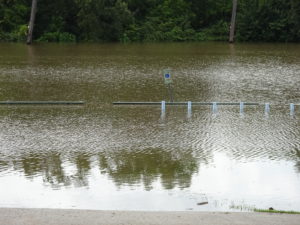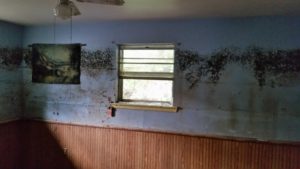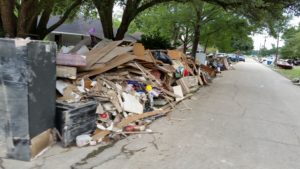I’ve been training for the Louisiana Marathon (@thelamarathon) these last few months. It (and other personal issues) admittedly sapped a lot of my free time and mental energy. So, I’ve been neglecting writing and blogging for about as long as I’ve been training, which is unfortunate because I wanted to blog about my training along the way. I can at least recap why I decided to run the marathon, how I trained for it, what the training was like, etc.
First, I ran the Louisiana Half-Marathon in January 2016 as part of Ainsley’s Angels and a group of coworkers that organize to push another coworker through the half marathon route. The company I work for was very supportive of the effort and made it into a big media event for us. I’ve avoided blogging about it or speaking too much about it on social media, because I try to keep my writing endeavors as separate as possible from my professional endeavors. I even wrote an article for the company newsletter about the experience that received a Hermes Gold Award, but thought it was best not to post a copy of the story on my personal site.

I can say it turned out to be a great experience. There were only a handful of veteran runners on our team and some of them were only with us until the half-marathon route split from the full marathon route. I have been running for years, but I considered a long run to be 5 miles. I believe I once ran a little more than 7 miles in my 20s, but that was it. When the fall before the race came around and I agreed to join the team, I had a lot of training to do. My coworkers gave me bits of advice, but I mainly just tackled it on my own, running in my neighborhood. Seven miles was easy to reach. 9 miles became a wall for me for a while. Sometime in October, I managed to run the full 13.1 miles and some more (closer to 14 miles). And I maintained this until the race in January, doing 6 mile runs mainly and the 13.1 miles runs a couple more times.
When the race came around, I was more than physically prepared for the run. But what made me hate even agreeing to the entire thing was having to go down to downtown Baton Rouge before the sun was up and wait in some of the worst cold January wind I had ever experienced in my life. I was miserable for hours until the race started, the winds died, the sun came up, and our team established a pace. The run turned into beautiful tour of the LSU campus and the nearby lakes, as well as parts of the Garden District.
What stuck with me, and motivated me to attempt the full marathon, was my memory of reaching the point in our route where the more veteran runners of our team went one way and we went the other. With roughly 10 miles into the run, I completely believed and felt that I could have gone with the veteran runners and done the full. Not only that, I wanted to go just to see if I could do it. So, I promised myself that if I was able to, I would sign up for the full marathon the next year. And I did.
The full marathon at 26.2 miles, however, is much more than just twice the distance of the half. It takes work, time, preparation, and experience to get to 26.2. When I reached that point where the routes split and thought I could have run the full, I would have failed, probably dying out around mile 16.
Knowing I would try for the full, I continued running on a regular basis as I normally did, but ran more longer routes of 5 and 6 miles more often. And when it came time to train, I sought advice from the Internet. I discovered Hal Higdon’s (@higdonmarathon) site and settled on his Novice 1 training. The training would begin with a weekend long run of 6 miles and peak with a weekend long run of 20 miles a few weeks before the race. Fearing inclement weather and potential illness, I started just before the LA Floods.
The training was a catastrophe, initially, at least. The heat index was regularly above 110 degrees F. And the three short, back-to-back runs during the work week were wearing me down. In fact, my entire body was wearing down. Where I was able to run 13.1 miles without issue, I struggled to run just 7 miles. My legs ached, my back ached, my body felt like a lead weight, and it didn’t matter how much water I drank; I would just overheat.
Thinking this was all due to just the extreme heat (which it partially was), I tried running on a tread mill in an air conditioned gym. And still, no dice.
My body was just worn out. It didn’t matter how much I slept or what I ate and drink or didn’t eat or drink. The training was damaging me a little more with each new run. I started to think there was something wrong with me, something I couldn’t just explain away with being older. I went to the Internet again and discovered the obvious.
Ibuprofen.
I would often take the OTC drug to treat aches and pains from working out, believing I was helping my body by reducing inflammation and ensuring a more restful sleep. In reality, I was handicapping my body’s ability to properly heal itself from exertion and recover. More than that, every time I had taken a couple pills a few hours after a run, I basically undid any benefit the run might have gained me with muscle and bone growth. It also seemed to screw with my body’s ability to properly hydrate itself. During my treadmill run, I actually became water-intoxicated and stepped off dizzy.
Ibuprofen is a great remedy for treating injury and the occasional injury of illness-produced body ache, but it’s not for the soreness that comes with training. Once I quit taking it, the training became a whole lot easier. Granted, I was apprehensive at first that I actually discovered what was holding me back, but the longer runs and shorter weekday runs got easier and easier. My legs became stronger and stronger. Any soreness I had after a run decreased in duration with each week, despite the miles I was running increasing. It was kind of startling and I’m curious what effect not taking the drug will have on any other training I plan to do after the full marathon.
So, discovering this about my favorite pain-reliever was a huge boost, but I ran into other problems.
Chaffing became a very serious concern. I finished the 15 mile training run bloody. I wasn’t completely unaware of the problem and had long since adopted the practice of protecting my nipples with band-aids. It sounds silly until you finish a run with bloody nipples and have to take a shower. That is pain, friend. Chaffing, too, becomes so much more exacerbated on longer runs with sweat-soaked clothing (dry-fit stuff doesn’t stay too dry when the humidity is well over 80%). I experimented with various runner lubricants for my more sensitive areas and found that the Gold Bond Friction Defense stick worked for me, as well as running in shorts with a lighter material.
With chaffing settled, I next had to contend with my running shoes wearing out. A couple of my long runs turned into complete slogs simply because my shoes were EOL. Various factors play into how long your running shows will last, but the ASICS running shoes I prefer are good for a little more than 200 miles before they die. This was an easy problem to fix, so long as I keep a mental odometer for my shoes.
I was able to run the longest run of the training, 20 miles, just before Thanksgiving. While it was a successful run I ran into another problem. I got to mile 18 and felt great. I even considered trying for the full 26.2 to see if I could do it. But between 18 and 20 miles, I ran out of gas. Finding that regular Gatorade is so sugary it makes me too thirsty during a run, I had been using the reduced-sugar G2 version, diluted with half as much water. And this worked great for balanced hydration. The weather had gotten cooler, so I wasn’t sweating as much, and I could sip this solution as I ran. It worked for me, except it only contained like 7g of carbohydrate. That’s not enough fuel for a 200 lbs. man to maintain a 5-hour run.
So, another problem and another fix. I needed more carbs. I switched back to the regular Gatorade (which makes me thirsty) and diluting it. How well this will work during the actual marathon, I can’t say. I’ll likely be sipping Powerade and water at the relief stations. But I managed a 17 miles run without that same kind of fatigue. Unfortunately, the run was stopped shorter than I would have liked by my running shoes being worn out and making my knees, ankles, feet, and hips hurt.
All these problems I’ve discussed have been physically in the nature, but the second biggest problem I faced during the training was the psychological aspect. Doing anything for 2, 3, 4, or 5 hours straight without a break taxes the mind. You can only loop the same neighborhood so many times before it starts to drive you crazy. Even falling into that meditative state many of us runners are familiar with carrying us through runs becomes fatiguing.
To counter this, I started running across major streets into other neighborhoods and, well, other parts of the city. New sights and curious holiday decorations helped, but only somewhat. I started running with my MP3 player, having to purchase a new one after sweat and salt killed the last one I had. On many of my longer runs, I’d listen to the LSU pre-game show on 98.1 and then about half the game itself. When football ended, I switched to the new Metallica album, Hardwired… To Self-Destruct. As much as I enjoyed the 3-disc special edition version of it, there was something just defeating about being on a run and having the album finish and restart from the beginning.
I can’t stress enough how much mental effort it takes to do these kinds of runs, unless you’re able to run them at a significantly faster pace. When I say the only thing I wanted to do after a long run was to watch TV or YouTube (not even play a game), I’m not kidding. Fortunately, the excitement surrounding the actual marathon, as well as running with friends and coworkers instead of on my own, should be a great help with the tedium.
The race is scheduled for January 15 and the weather should be good. I don’t like going into it never having run the full race distance before. So, I’m putting my faith in the training I endured and “race magic,” as the veteran runners call it. I’ll eat my same pre-run meal of peanut butter and jelly sandwiches for breakfast and see how it goes. My predicted completion time sits between 5 and 5.5 hours, but I would like to finish under 5 if I’m able. I guess we’ll see at the 2017 Louisiana Marathon (@lamarathon).
On a side note: I’m resolving myself to contributing more often to my site, as well as getting to work on Divergent Chill III.








